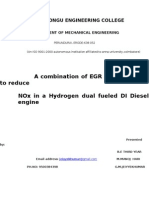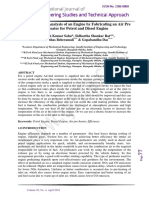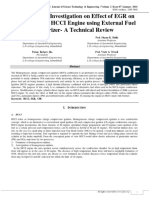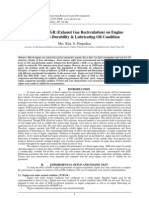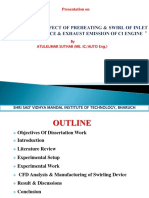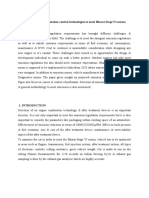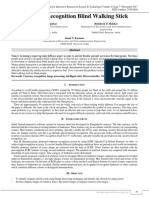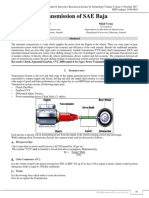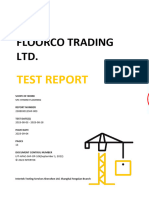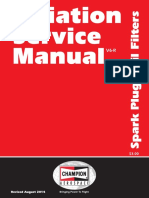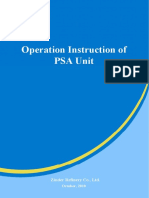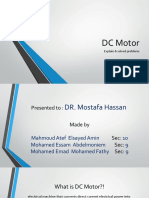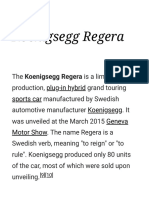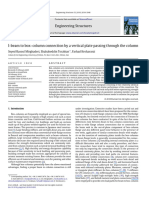Performance and Emission Analysis of Compression Ignition Engine With Exhaust Gas Recirculation and Ethanol Fumigation
Performance and Emission Analysis of Compression Ignition Engine With Exhaust Gas Recirculation and Ethanol Fumigation
Uploaded by
IJIRSTCopyright:
Available Formats
Performance and Emission Analysis of Compression Ignition Engine With Exhaust Gas Recirculation and Ethanol Fumigation
Performance and Emission Analysis of Compression Ignition Engine With Exhaust Gas Recirculation and Ethanol Fumigation
Uploaded by
IJIRSTOriginal Title
Copyright
Available Formats
Share this document
Did you find this document useful?
Is this content inappropriate?
Copyright:
Available Formats
Performance and Emission Analysis of Compression Ignition Engine With Exhaust Gas Recirculation and Ethanol Fumigation
Performance and Emission Analysis of Compression Ignition Engine With Exhaust Gas Recirculation and Ethanol Fumigation
Uploaded by
IJIRSTCopyright:
Available Formats
IJIRST International Journal for Innovative Research in Science & Technology| Volume 3 | Issue 05 | October 2016
ISSN (online): 2349-6010
Performance and Emission Analysis of
Compression Ignition Engine with Exhaust Gas
Recirculation and Ethanol Fumigation
T. Vivek Asalan R. K. Kalaiselvan
Assistant Professor Assistant Professor
Department of Mechanical Engineering Department of Mechanical Engineering
CK College of Engineering & Technology Cuddalore CK College of Engineering & Technology Cuddalore
Tamil Nadu Tamil Nadu
Abstract
One of the undesirable emissions from diesel engine is NOx emission. In order to reduce NOx emission exhaust gas recirculation
is used. Regulations to reduce NOx emissions continue to become more and more stringent year by year. Exhaust gas
recirculation (EGR) is one of the techniques used to reduce nitrogen oxides because it lowers flame temperature in the
combustion chamber. However as NOx reduces, hydrocarbon (HC) emissions and smoke level increases. As the EGR rate
increases the engine operation becomes instable and there is a little reduction in thermal efficiency. Alcohol fumigation is a
technique used for reducing emissions and improving the thermal efficiency of the engine. An experimental set up is fabricated
to facilitate EGR and ethanol fumigation in the inlet duct of the engine. Engine performance, NOx and HC emissions without
EGR, with EGR and with EGR and ethanol fumigation are presented in this work.
Keywords: Engine performance, EGR, ethanol fumigation, NOx, HC, emission
_______________________________________________________________________________________________________
I. INTRODUCTION
Compression ignition (diesel) engines have high thermal efficiencies resulting from their high compression ratio and fuel lean
operation. The high compression ratio produces the high temperature required to achieve auto ignition. During mixing of diesel
fuel with air, different air-fuel ratios are formed. However high flame temperatures predominate because locally stoichiometric
air-fuel ratios prevail in such heterogeneous combustion process. Consequently large amount of NOx are formed.
Some of the after treatment devices that reduces Nox emissions are, Diesel Oxidation Catalyst (DOC), Diesel Particulate Filter
(DPF), Selective Catalytic Reduction (SCR) and NOX Storage Catalyst (NSC).
Instead of using after-treatment systems to comply with exhaust emission legislation, it is also possible to avoid the formation
of emissions during the combustion. The raw emissions are reduced and thus no after-treatment is needed. It is common practice
nowadays, to use EGR to reduce the formation of NOX emissions. A portion of the exhaust gas is re circulated into the
combustion chambers. This can be achieved either internally with the proper valve timing, or externally with some kind of
piping.
The exhaust gas acts as an inert gas in the combustion chamber, it does not participate in the combustion reaction. This leads
to a reduction of the combustion temperature by different effects. The fuel molecules need more time to find oxygen molecule to
react with, as there are inert molecules around. This slows down the combustion speed and thus reduces the peak combustion
temperature, as the same amount of energy is released over a longer period of time. The energy is also used to heat up a larger
gas portion than it would without EGR. As the air is diluted with exhaust gas, the mass of a gas portion containing the needed
amount of oxygen gets bigger.
Another effect is the change in heat capacity. Exhaust gas has a higher specific heat capacity than air, due to the CO2-
molecules higher degree of freedom. So for the same amount of combustion energy a gas mass containing EGR will get a lower
temperature than pure air. The lower combustion temperature directly reduces the NOX formation, as the NOX formation rate is
highly temperature dependent.
One of the methods of utilizing ethanol in diesel engines is by means of fumigation, i.e., the introduction of ethanol into the
intake manifold of a diesel engine. It is a form of dual-fuel operation where part of the fuel is premixed with the intake air, and
part is injected into the cylinder as in a regular diesel engine. This injection of alcohol can be accomplished by means of a
carburetor, atomizing nozzles, electronically-controlled fuel injectors, etc. Alcohol fumigation is a relatively simple and
uncomplicated method which also features some important advantages: it can be made easily retro-fittable to existing engines
and it easily allows the engine to switch back to neat diesel operation at any time. Unlike diesel-ethanol blends, miscibility does
not pose a problem and in general, depending on several factors, the fumigation technique is able to replace up to about 50% of
energy from diesel fuel.
All rights reserved by www.ijirst.org 157
Performance and Emission Analysis of Compression Ignition Engine with Exhaust Gas Recirculation and Ethanol Fumigation
(IJIRST/ Volume 3 / Issue 05/ 029)
II. EXPERIMENTAL SET UP
Experimental set up consists of the following three parts
Engine set up to measure load, rpm and fuel consumption which consists of eddy current dynamometer, control panel
and burette.
Table 1
CI Engine Specification
Engine Kirloskar tv1
Bore*stroke 87.5mm*110mm
Cubic Capacity 661 cm3
Compression Ratio: 17.5:1
Rated output: 5.2kw at 1500 rpm
Fuel injector pressure 20-25Mpa
Injection timing 23 degree before TDC
No of valves 2
Valve timing 4.5 degree
Inlet valve opens BTDC 35.5 degree
Inlet valve opens ABDC 35.5 degree
Exhaust valve opens BBDC 4.5 degree
Governor type mechanical ,centrifugal type
Class of governing B1
Fuel injection type Mechanical individual pump
EGR and ethanol fumigation set up which is newly fabricated to facilitate EGR and ethanol fumigation which consists of
orifice meter, manometer, burette, EGR flow control valve and ethanol flow control key. (Figure 2.1)
Fig. 2.1: Newly developed EGR and ethanol fumigation set up
Orifice meter
It is a device used for measuring the rate of flow of a fluid through a pipe. It is based on the principle of Bernoullis equation. It
consists of a flat circular plate which has a circular sharp edged hole called orifice, which is concentric with the pipe.
Manometer
It consists of U tube attached to the two ends of orifice meter. It shows the head difference across the orifice meter. From the
head difference volume flow rate is measured. The manometer limbs are filled with water.
EGR flow control valve
It is used to vary the flow of the exhaust gas into the inlet manifold of the engine
Ethanol flow control key
It is used to control the flow of ethanol into the inlet manifold of the engine
1) Emission measurement setup which consists of Five Gas Analyzer and Smoke meter.
All rights reserved by www.ijirst.org 158
Performance and Emission Analysis of Compression Ignition Engine with Exhaust Gas Recirculation and Ethanol Fumigation
(IJIRST/ Volume 3 / Issue 05/ 029)
III. RESULTS AND DISCUSSION
The following Figure3.1 shows the variation of thermal efficiency with brake power for 20%EGR with ethanol fumigation. EGR
decreases thermal efficiency whereas ethanol fumigation increases the thermal efficiency. This is due to ignition delay which
makes sudden release of heat so that no time is allowed for heat to be conducted to engine coolant.
Fig. 3.1: Variation of thermal efficiency with BP for 20% EGR with ethanol fumigation
The following Figure3.2 shows variation of specific fuel consumption with brake power for 20% EGR with ethanol
fumigation. Bsfc increases with EGR and decreases with ethanol fumigation. Ethanol is an additional source of fuel.
Fig. 3.2: Variation of bsfc with BP for 20% EGR with ethanol fumigation
The following Figure 3.3shows variation of NOx with brake power for 20% EGR with ethanol fumigation. NOx emission
decreases with EGR and it further reduces with ethanol fumigation. It is due to dilution and cooling effect of alcohol in the
combustion chamber.
All rights reserved by www.ijirst.org 159
Performance and Emission Analysis of Compression Ignition Engine with Exhaust Gas Recirculation and Ethanol Fumigation
(IJIRST/ Volume 3 / Issue 05/ 029)
Fig. 3.3: Variation of NOx with BP for 20% EGR with ethanol fumigation
The following Figure3.4 shows variation of HC with brake power for 20% EGR with ethanol fumigation. HC increases with
EGR and it greatly increases with ethanol fumigation. This is due to the fact that alcohol quench layer is formed and all the
fumigated ethanol is not participating in combustion.
Fig. 3.4: Variation of HC with BP for 20% EGR with ethanol fumigation
The following Figure3.5 shows variation of smoke meter reading with brake power for 20%EGR with ethanol fumigation.
Smoke opacity increases with EGR and it further increases with ethanol fumigation. This is due to the fact that some alcohols are
escaping without participating in combustion.
Fig. 3.5: Variation of smoke meter reading with BP for 20% EGR with ethanol fumigation
All rights reserved by www.ijirst.org 160
Performance and Emission Analysis of Compression Ignition Engine with Exhaust Gas Recirculation and Ethanol Fumigation
(IJIRST/ Volume 3 / Issue 05/ 029)
IV. CONCLUSION
The present investigation is about fabrication of exhaust gas recirculation and ethanol fumigation set up and
experimentation of various engine performance and emission with that set up.
The following points can be concluded from the results obtained from the experiment.
Thermal efficiency is decreased as the result of EGR. It increases with ethanol fumigation.
Brake specific fuel consumption increases as EGR rate increases. But bsfc decreases with ethanol fumigation.
EGR reduces NOx very effectively. When EGR rate is increased NOx is decreased accordingly. NOx formation further gets
reduced with ethanol fumigation.
HC emission increases with EGR. It increases significantly with ethanol fumigation.
REFERENCES
[1] Heywood John B., Internal combustion engine fundamentals. (McGraw-Hill)
[2] V Ganesan, Internal combustion engines, Third Edition, (The McGraw-Hill Companies)
[3] Ming Zheng, Graham T.Reader, J. Gary Hawley, Diesel engine exhaust gas recirculation- a review on advanced and novel concepts, Energy conversion
and management, 45, pp. 883-900, 2004
[4] Avinash Kumar Agrawal, Shrawan Kumar Singh, Effect of EGR on the exhaust gas temperature and exhaust opacity in compression ignition engines,
Sadhana Vol.29, Part 3,pp. 275-284, June 2004.
[5] P.V.Walke, Dr.N.V.Deshpande, R.G.Bodkhe, Impact of exhaust gas recirculation on the performances of diesel engine, Proceedings of the World Congress
on Engineering, Vol. 2, London, U.K, July2-4, 2008.
[6] K.Rajan, K.R.Senthilkumar, Effect of EGR on the performance and emission characteristics of diesel engine with sunflower oil methyl ester, JJMIE, Vol. 3,
No 4, ISSN 1995-6665, pp. 306-311, December 2009.
[7] M.Ghazikhani, M.R.Kalateh,Y.K.Toroghi,andM.Dehnavi, An Experimental study on the effect of EGR and Engine Speed on CO and HC emissions of dual
fuel HCCI engine, World Academy of Science, Engineering and Technology, 52, 2009.
[8] A.Paykani, A.Akbarzadeh, and M.T.ShervaniTabar, Experimental investigation of the effect of exhaust gas recirculation on performance and emissions
characteristics of a diesel engine fueled with biodiesel, IACSIT, International Journal of Engineering and Technology, Vol.3,No.3, June 2011
[9] AndrzejBieniek, MariuszGraba,AndrzejLechowicz, Adaptive control of exhaust gas recirculation at nonroad vehicle diesel engine, Journal of KONES
Powertrain and transport , Vol.18, No.4,2011.
[10] Gurumoorthy.SHebbar, Ananthakrishnabhat, Control of NOx from a DI diesel engine with hot EGR and ethanol fumigation. An experimental investigation,
IOSRJEN, ISSN:2250-3021 Vol. 2, Issue 7,pp. 45-53, July 2012..
[11] M.Abu-Qudais, O.Haddad, M.Qudaisat, The effect of alcohol fumigation on diesel engine performance and emissions, Energy Conversion& Management
41, pp. 389-399, 2000.
All rights reserved by www.ijirst.org 161
You might also like
- A Combination of Egr and Urea-Scr To Reduce Nox in A Hydrogen Dual Fueled Di Diesel EngineDocument24 pagesA Combination of Egr and Urea-Scr To Reduce Nox in A Hydrogen Dual Fueled Di Diesel EngineSan SuryaNo ratings yet
- Danis TechnocialDocument12 pagesDanis TechnocialAnonymous tJgb9yNo ratings yet
- International 7600 Specification SheetDocument4 pagesInternational 7600 Specification SheetJuan Pablo Maque CastilloNo ratings yet
- Knock Characteristics of Dual-Fuel Combustion in Diesel Engines Using Natural Gas As Primary FuelDocument8 pagesKnock Characteristics of Dual-Fuel Combustion in Diesel Engines Using Natural Gas As Primary FuelMohammad SafreedNo ratings yet
- Exhaust Gas Recirculation PPT FINALDocument20 pagesExhaust Gas Recirculation PPT FINALAniket Khaire100% (1)
- Methods of Improving Engine Performance and EfficiencyDocument34 pagesMethods of Improving Engine Performance and EfficiencyDavid ChikuseNo ratings yet
- 15IJMPERDFEB201915Document10 pages15IJMPERDFEB201915TJPRC PublicationsNo ratings yet
- E Ects of Diluent Admissions and Intake Air Temperature in Exhaust Gas Recirculation On The Emissions of An Indirect Injection Dual Fuel EngineDocument13 pagesE Ects of Diluent Admissions and Intake Air Temperature in Exhaust Gas Recirculation On The Emissions of An Indirect Injection Dual Fuel EngineAnuj PalNo ratings yet
- Performance Analysis of An Engine by Fabricating An Air Pre PDFDocument7 pagesPerformance Analysis of An Engine by Fabricating An Air Pre PDFhridoy bosuniaNo ratings yet
- Performance and Emission Parameters Analysis of Gasoline Engine With EGRDocument5 pagesPerformance and Emission Parameters Analysis of Gasoline Engine With EGRIJERDNo ratings yet
- Ssp371-The 2.5 Tdi in The CrafterDocument30 pagesSsp371-The 2.5 Tdi in The Crafterflyingspann3rNo ratings yet
- Energy Conversion and Management: S. D'ambrosio, A. FerrariDocument12 pagesEnergy Conversion and Management: S. D'ambrosio, A. FerrariCostin DanielNo ratings yet
- Experimental Investigation On Effect of EGR On Biofuel Fueled HCCI Engine Using External Fuel VaporizerDocument5 pagesExperimental Investigation On Effect of EGR On Biofuel Fueled HCCI Engine Using External Fuel Vaporizerthomas.lauxNo ratings yet
- BAB II Narasimha 2013Document6 pagesBAB II Narasimha 2013cahyotripambudiNo ratings yet
- Modification To Fuel Supply System of Honda CD125 Motorcycle EngineDocument4 pagesModification To Fuel Supply System of Honda CD125 Motorcycle EngineInternational Journal of Innovative Science and Research TechnologyNo ratings yet
- Exhaust Gas Recirculation PresentationDocument18 pagesExhaust Gas Recirculation PresentationMukesh sutharNo ratings yet
- Conversion of Internal Combustion Engine From Gasoline To E85 FuelDocument5 pagesConversion of Internal Combustion Engine From Gasoline To E85 FuelAasif SheikhNo ratings yet
- Stepen Kompresije RadDocument10 pagesStepen Kompresije Radcaligula9955No ratings yet
- Optimization of EGR Rate On Multi Cylinders 4-Stroke Diesel Engine.Document7 pagesOptimization of EGR Rate On Multi Cylinders 4-Stroke Diesel Engine.Inder MukhopadhyayNo ratings yet
- 231 JT339Document5 pages231 JT339Vinoth Kumar VinsNo ratings yet
- Influence of EGR (Exhaust Gas Recirculation) On Engine Components Durability & Lubricating Oil ConditionDocument6 pagesInfluence of EGR (Exhaust Gas Recirculation) On Engine Components Durability & Lubricating Oil ConditionIJERDNo ratings yet
- دليل مختبر محركاتDocument69 pagesدليل مختبر محركاتabood mohammadNo ratings yet
- Analysis and Experimental Research On The Influence of VVT Point Selection On Exhaust Temperature in Low Speed Operating ConditionsDocument8 pagesAnalysis and Experimental Research On The Influence of VVT Point Selection On Exhaust Temperature in Low Speed Operating Conditionsrosca raulNo ratings yet
- Addition of Nanoparticles With Diesel Fuel For Improving The Performance of EngineDocument12 pagesAddition of Nanoparticles With Diesel Fuel For Improving The Performance of EngineaNo ratings yet
- 1 s2.0 S1359431102000406 Main PDFDocument13 pages1 s2.0 S1359431102000406 Main PDFEderNo ratings yet
- Reducing Emissions With Exhaust Gas Recirculation SystemsDocument12 pagesReducing Emissions With Exhaust Gas Recirculation SystemsAmr IbrahimNo ratings yet
- E01 ME Lab II Manual Mod KADocument4 pagesE01 ME Lab II Manual Mod KAVishnu SelvamNo ratings yet
- Exhaust Gas Recirculation ReportDocument19 pagesExhaust Gas Recirculation ReportAjith100% (1)
- Increase of Thermal Efficiency and Reduction of Nox Emissions in Di Diesel EnginesDocument5 pagesIncrease of Thermal Efficiency and Reduction of Nox Emissions in Di Diesel EnginesShreepal ChilaNo ratings yet
- Advanced Ic EnginesDocument13 pagesAdvanced Ic EnginesVenkatesh MecNo ratings yet
- Effect of EGR On Diesel EngineDocument17 pagesEffect of EGR On Diesel EngineVikas PoddarNo ratings yet
- Improved Design of Air Flow For A Two Stroke Internal Combustion Engine Without Scavenging Problems To Promote Cleaner CombustionDocument10 pagesImproved Design of Air Flow For A Two Stroke Internal Combustion Engine Without Scavenging Problems To Promote Cleaner CombustionTJPRC PublicationsNo ratings yet
- Turbocharger Matching For Two Cylinder Constant Speed Diesel Engine With Uneven Firing OrderDocument8 pagesTurbocharger Matching For Two Cylinder Constant Speed Diesel Engine With Uneven Firing OrderTJPRC PublicationsNo ratings yet
- Heat Balance Sheet of Single Cylinder Diesel Engine by Introducing Oxygen in The Air IntakeDocument7 pagesHeat Balance Sheet of Single Cylinder Diesel Engine by Introducing Oxygen in The Air IntakeBharath SaravananNo ratings yet
- 27IJMPERDAPR201927Document10 pages27IJMPERDAPR201927TJPRC PublicationsNo ratings yet
- El Sistema Egr en Common RailDocument4 pagesEl Sistema Egr en Common RailpepeladazoNo ratings yet
- Bme Module 4Document32 pagesBme Module 4eldhosekjnitNo ratings yet
- Economiser Energy Control For Increased Service Steam Production EngDocument20 pagesEconomiser Energy Control For Increased Service Steam Production EngSwayam JeetNo ratings yet
- Engine Performance Parametres and Emissions Reduction Methods For Spark Ignition EngineDocument26 pagesEngine Performance Parametres and Emissions Reduction Methods For Spark Ignition Enginekirthib_1No ratings yet
- Performance Test On A Four Stroke Single Cylinder Diesel Engine Using Biodiesel With Cooled EGR MethodDocument10 pagesPerformance Test On A Four Stroke Single Cylinder Diesel Engine Using Biodiesel With Cooled EGR Methodedison avvaiNo ratings yet
- JJMIE 41 09 Modified SOIDocument8 pagesJJMIE 41 09 Modified SOIED LiNo ratings yet
- Ic Engine Project ReportDocument6 pagesIc Engine Project ReportAtulkumarSutharNo ratings yet
- NRF Technical Article EGR and Why We Need EGR Coolers ENDocument3 pagesNRF Technical Article EGR and Why We Need EGR Coolers ENRicko Cah X-FriendNo ratings yet
- CEP Ic EngineDocument8 pagesCEP Ic EngineUsama ArifNo ratings yet
- Diesel Car EmissionsDocument9 pagesDiesel Car Emissionsjignesh patilNo ratings yet
- Exhaust Gas RecirculationDocument4 pagesExhaust Gas RecirculationAjitKumarPandeyNo ratings yet
- Gas Engines Prechamber Vs OpenDocument13 pagesGas Engines Prechamber Vs Openvictor.ciprianiNo ratings yet
- "Genset Engine Development To Meet Current Emission Norms" (Conversion From CPCB-I To CPCB-II)Document4 pages"Genset Engine Development To Meet Current Emission Norms" (Conversion From CPCB-I To CPCB-II)inventionjournalsNo ratings yet
- Combustion of Dual Fuel Type Natural GasLiquid Diesel Fuel in CompressionChaichan14Document12 pagesCombustion of Dual Fuel Type Natural GasLiquid Diesel Fuel in CompressionChaichan14ennioNo ratings yet
- Gasoline Engine Management Systems and Components: September 2018Document100 pagesGasoline Engine Management Systems and Components: September 2018Tunde OlaoyeNo ratings yet
- Exhaust Gas Recirculation ReportDocument21 pagesExhaust Gas Recirculation ReportJignesh Rohit100% (2)
- Effect of Preheating of Inlet Air To Study PDFDocument5 pagesEffect of Preheating of Inlet Air To Study PDFhridoy bosuniaNo ratings yet
- Emissions Control Unit For Diesel Engine ExhaustDocument7 pagesEmissions Control Unit For Diesel Engine ExhaustammarNo ratings yet
- Diesel Engine ReportDocument21 pagesDiesel Engine Reportengrvj57No ratings yet
- Experimental Investigation of Combustion, Performance and Emission Characteristics of Di Diesel Engine Under Hcci Mode With Porous Medium CombustionDocument10 pagesExperimental Investigation of Combustion, Performance and Emission Characteristics of Di Diesel Engine Under Hcci Mode With Porous Medium CombustionkannanjbrNo ratings yet
- Emission Control On IC EngineDocument18 pagesEmission Control On IC Enginetarunskumar89% (19)
- Effect of Inlet Air Temperature On HCCI Engine Fuelled With Diesel - Eucalyptus Fuel BlendsDocument8 pagesEffect of Inlet Air Temperature On HCCI Engine Fuelled With Diesel - Eucalyptus Fuel BlendsIJRASETPublicationsNo ratings yet
- Exhaust Gas Recirculation ReportDocument18 pagesExhaust Gas Recirculation Reportashoku2No ratings yet
- Comparison of Diesel and Petrol EnginesFrom EverandComparison of Diesel and Petrol EnginesRating: 2.5 out of 5 stars2.5/5 (3)
- Patterns of Crop Concentration, Crop Diversification and Crop Combination in Thiruchirappalli District, Tamil NaduDocument10 pagesPatterns of Crop Concentration, Crop Diversification and Crop Combination in Thiruchirappalli District, Tamil NaduIJIRSTNo ratings yet
- Development of Satellite Data For Infrastructure Updation and Land Use/Land Cover Mapping - A Case Study From Kashipur & Chhatna Block, Bankura & Purulia District, West BengalDocument7 pagesDevelopment of Satellite Data For Infrastructure Updation and Land Use/Land Cover Mapping - A Case Study From Kashipur & Chhatna Block, Bankura & Purulia District, West BengalIJIRSTNo ratings yet
- Arduino-UNO Based Magnetic Field Strength MeasurementDocument4 pagesArduino-UNO Based Magnetic Field Strength MeasurementIJIRSTNo ratings yet
- Currency Recognition Blind Walking StickDocument3 pagesCurrency Recognition Blind Walking StickIJIRSTNo ratings yet
- Satellite Dish Positioning SystemDocument5 pagesSatellite Dish Positioning SystemIJIRST100% (1)
- Literature Review For Designing of Portable CNC MachineDocument3 pagesLiterature Review For Designing of Portable CNC MachineIJIRSTNo ratings yet
- Development of Tourism Near Loktak Lake (Moirang) in Manipur Using Geographical Information and Management TechniquesDocument4 pagesDevelopment of Tourism Near Loktak Lake (Moirang) in Manipur Using Geographical Information and Management TechniquesIJIRSTNo ratings yet
- Transmission of SAE BajaDocument5 pagesTransmission of SAE BajaIJIRST100% (1)
- Analysis and Design of Shear Wall For An Earthquake Resistant Building Using ETABSDocument7 pagesAnalysis and Design of Shear Wall For An Earthquake Resistant Building Using ETABSIJIRSTNo ratings yet
- Social Impact of Chukha Hydro Power On Its Local Population in BhutanDocument2 pagesSocial Impact of Chukha Hydro Power On Its Local Population in BhutanIJIRSTNo ratings yet
- Automated Online Voting System (AOVS)Document4 pagesAutomated Online Voting System (AOVS)IJIRSTNo ratings yet
- Analysis of Fraudulent in Graph Database For Identification and PreventionDocument8 pagesAnalysis of Fraudulent in Graph Database For Identification and PreventionIJIRSTNo ratings yet
- Modeled Sensor Database For Internet of ThingsDocument4 pagesModeled Sensor Database For Internet of ThingsIJIRSTNo ratings yet
- Test Report ISO 24342-2018 - Intertek (Page 4)Document22 pagesTest Report ISO 24342-2018 - Intertek (Page 4)sarinurkhsnhNo ratings yet
- Installation of Precision Air Conditioner (Autosaved)Document10 pagesInstallation of Precision Air Conditioner (Autosaved)Parikshit SharmaNo ratings yet
- Plano Hidráulico 950hDocument14 pagesPlano Hidráulico 950hWeslin Carlos Ramirez CamizanNo ratings yet
- AV6 R Aug20141Document28 pagesAV6 R Aug20141Fran GaritaNo ratings yet
- PSA Operation ManualDocument83 pagesPSA Operation ManualAbassyacoubouNo ratings yet
- Advanced Heat Transfer Analysis of Continuously Variable Transmissions (CVT) PDFDocument9 pagesAdvanced Heat Transfer Analysis of Continuously Variable Transmissions (CVT) PDFDaniel Escobar100% (1)
- DC Motor: Explain & Solved ProblemsDocument25 pagesDC Motor: Explain & Solved ProblemsAlieEldeenNo ratings yet
- Guía de Uso PID para ArduinoDocument45 pagesGuía de Uso PID para ArduinoTatiana Moreno MNo ratings yet
- Resume 1Document3 pagesResume 1SANTOSH CHAUHANNo ratings yet
- Thumb Rules For Steel&Concrete DesignDocument11 pagesThumb Rules For Steel&Concrete DesigngvgbabuNo ratings yet
- Koenigsegg RegeraDocument111 pagesKoenigsegg RegeraIgor Rihtar100% (1)
- Design of Bearing Replacement ArrangementDocument19 pagesDesign of Bearing Replacement ArrangementShivendra KumarNo ratings yet
- Car Operating Systems: Ryan BeneskyDocument31 pagesCar Operating Systems: Ryan BeneskySapari VelNo ratings yet
- Determining The Short Term Tensile Weld Strength of Chemical-Resistant ThermoplasticsDocument4 pagesDetermining The Short Term Tensile Weld Strength of Chemical-Resistant ThermoplasticsFernando Da RosNo ratings yet
- GT ManualDocument10 pagesGT Manualsoldatbr4183No ratings yet
- Crimping Permanent Couplings Using The 136-3642 Crimp Tool Group in Combination and XT Hose Machines1Document16 pagesCrimping Permanent Couplings Using The 136-3642 Crimp Tool Group in Combination and XT Hose Machines1benjir shuvoNo ratings yet
- Draft Formworks Estimate For 56ml San Juan ReservoirDocument14 pagesDraft Formworks Estimate For 56ml San Juan Reservoirmarchus09No ratings yet
- Sup 0014Document33 pagesSup 0014Tomy lee youngNo ratings yet
- Catálogo DensoDocument358 pagesCatálogo DensoAlan MarcioNo ratings yet
- Check All Visible Parts in Engine Compartment For Damage and Fluid LossDocument2 pagesCheck All Visible Parts in Engine Compartment For Damage and Fluid Lossx7c56d5zy8No ratings yet
- HCC-13087 Schlick Nozzle MDL 940Document15 pagesHCC-13087 Schlick Nozzle MDL 940colourdragonandyNo ratings yet
- I-Beam To Box Column Connection by A VerDocument15 pagesI-Beam To Box Column Connection by A VerHenry CzenczekNo ratings yet
- Formulas For Compression Spring DesignDocument3 pagesFormulas For Compression Spring DesignVenkateswaran venkateswaranNo ratings yet
- 300 SS Bolting FailureDocument3 pages300 SS Bolting FailureInspection EngineerNo ratings yet
- Afflux at Culverts and BridgesDocument32 pagesAfflux at Culverts and BridgesAsif MuhammadNo ratings yet
- Output Equation of Induction MotorDocument23 pagesOutput Equation of Induction MotorusmanNo ratings yet
- Design Fundamentals For Sprinkler SystemDocument14 pagesDesign Fundamentals For Sprinkler SystemMancoba MbhamaliNo ratings yet
- Design of A Material Handling Equipment: Belt Conveyor System For Crushed Limestone Using 3 Roll IdlersDocument8 pagesDesign of A Material Handling Equipment: Belt Conveyor System For Crushed Limestone Using 3 Roll IdlersRushikesh TajneNo ratings yet
- High Altitude Bell 47Document14 pagesHigh Altitude Bell 47Sesquipedaliac100% (1)
